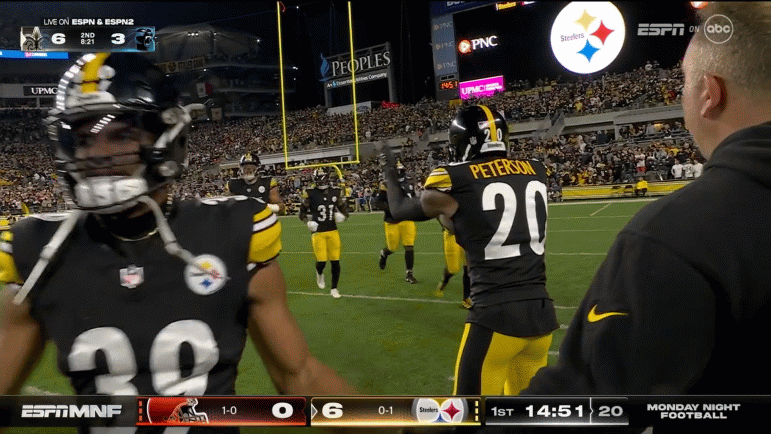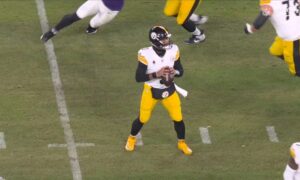There’s no question the defense is the stronger of the Pittsburgh Steelers’ two units. That much is obvious. They’re dragging the anchor that is the offense around, trying to stay afloat. The offensive issues have put additional strain on this defense. Forcing them out there to play extra snaps, fewer breaks between possessions, and asking them to do pretty much everything. Even Mike Tomlin’s expectations have bordered on unrealistic. Three turnovers, ho-hum. How about you do more to help the offense score? You know what, forget about that. Every turnover should end in a pick-six.
But this defense isn’t without fault. As much focus and blame that should be on the offense, all of it deserved, the Steelers’ defense has its holes too. If Pittsburgh’s offense is famine, the defense is feast/famine. They make big plays. Through seven games, they’re second in the NFL in takeaways with 15 of them. And of the teams that have had a bye week, their 22 sacks rank third leaguewide.
Then there’s the other side. This is a unit that gives up big plays. Lots of them. On the season, the defense has allowed 28 receptions of 20-plus yards, fourth-most of any team. On average, the Steelers allow exactly four per game, tied for the third-highest per-game average in the league, only trailing the Washington Commanders and Los Angeles Chargers.
By game, here’s how many Pittsburgh has given up:
49ers – 3
Browns – 2
Raiders – 2
Texans – 6
Ravens – 2
Rams – 7
Jaguars – 5
Things have only gotten worse as the season’s gone on (and they could’ve given up four or five to Baltimore had it not been for the Ravens’ repeated drops). Pittsburgh’s secondary just lacks big-time personnel. There’s a piece, FS Minkah Fitzpatrick is a stud, though he’s had to cover the slot and play closer to the line of scrimmage because the team lacks defined personnel at slot and strong safety. Fitzpatrick is now out for at least Thursday’s game with a hamstring injury, potentially longer (has any Steeler missed just one game with a hamstring this season?), and his loss was immediately evident in the Jags game. Damontae Kazee was too aggressive and responsible for some of the big plays allowed, including RB Travis Etienne’s 56-yard touchdown. Those are mistakes Fitzpatrick just doesn’t make.
At corner, there’s Joey Porter Jr., who has played as well as you could hope for as a rookie, even if the team took its time to make him the starter. Beyond him, the cupboard looks bare. Patrick Peterson lacks the speed to play on the outside, Levi Wallace is having a miserable season, and Chandon Sullivan lacks a defining trait in the slot. While not high-end players, it’s obvious this team misses CB Cam Sutton and SS Terrell Edmunds and their dependability, versatility, and clear roles in the Steelers’ system. The defense struggled allowing the big play last year but Pittsburgh’s on pace to allow 13 more this year than in 2022.
It’s a secondary of those names and others like Keanu Neal, a box safety asked to expand his role with Fitzpatrick out. Heck, Miles Killebrew even became the dime defender Sunday. He’s a quality special teamer but not someone who should be seeing a single pass-down snap. Why Killebrew got the nod of Elijah Riley is unknown, not that it’s dramatically changing the shape of this defense.
In-season, there’s little the team can do about it. The Steelers can play “safer” coverages, more two-high, but that leaves them vulnerable to the run, which they’ve struggled to stop all year. The only offense they’ve held under the century mark was the Las Vegas Raiders in Week Three. In the offseason, secondary will again be a primary area of focus with right cornerback, nickel back, and strong safety all serious areas this team will need to zero in on.
The reality is this defense has to be the anchor. It has little margin for error even if it’s far from a stout or elite unit. This has to be the group that carries this team the rest of the way. Expecting more from this offense is valid. But the odds of it occurring on a consistent basis seems unlikely.
Overall, the defense has held up its end of the team’s winning model. It has kept the score down, created splash, bought time for the offense to mill around until it decides to go on a scoring drive. But if there’s an area for improvement, it’s keeping the ball in front of them. They don’t have much of a choice but find ways to get better.








